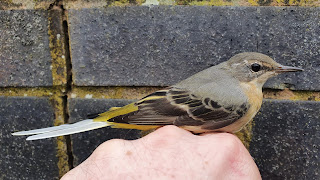Several teams were out this weekend with varying results--but overall another 200+ new birds were ringed--almost all migrants.
I'll not go into detail of each site--except to say that Ben scored well yet again at his Witches Oak site--even after taking a dunking in the lake and spending all night in damp clothes ready for an early start on Saturday--way beyond expectation!
Some highlights were 121 Blackcap, 70 Chiffchaff ( see below), 10 Sedge Warbler, 11 Reed Warbler (both quite late), and our much anticipated first Meadow Pipit of the season ( see below)
A few of the birds we caught yet again showed some really interesting features--starting with a female Chaffinch:-
Female Chaffinches can be a bit tricky to age--but this one is an adult as can be sen by the smooth rounded tail feathers which it has just grown as replacements for those it had used for the last year or so.
Next up is a couple of pictures of the Meadow Pipit mentioned above:-
Meadow Pipits ( aka mipits)--are very common upland breeders across Europe and during late September millions fly generally south and west ; many spending winter in central Spain down to southern Portugal. They are very variable in colour--this is a pretty standard brown one--but some are grey, others olive green. They also have a moult pattern which is also very variable--but this bird showed a classic pattern showing it is a juvenile bird. This can be seen on the closed wing quite easily:-
I have drawn some white brackets on the wing showing the greater covert feathers. Those on the left are labelled Ad--because these are feathers which the bird has recently grown in to replace juvenile feathers and they are browny/buff tipped. On the right the feathers are white tipped and these are juvenile feathers which the bird has not yet moulted out and replaced with adult feathers. Would that they were all as easy as this one!!
Finally the ever vigilant Liz, spotted this Chiffchaff among the 59 we caught at Belvide....... First off it was bigger with a longer wing (63mm) than the others we caught, with a heavier bill and a drabber, grey brown plumage. The left bird is a 'standard', the right is the interesting one:-
The stripe above the eye and the ring around the eye have no yellow on as in the standard bird:-
And there is very little yellow on the underside. Most striking is the lack of any yellow in the axillary ( armpit) region, which on standard birds is bright lemon yellow:-
Now, Chiffchaffs are very widespread across Europe, and they have several subspecies/races. This may have been a bird which was just showing normal variation within a very large population--or it could have been a northern European race which generally show these kinds of characteristics. I guess the only way we will really know is if some ringer in Norway/Sweden or points east manages to retrap the bird next year--we can always hope.














